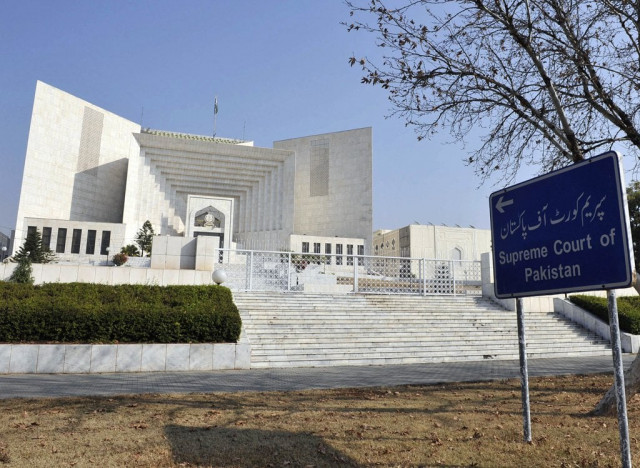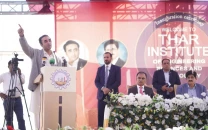SC restores sacked workers ‘under suo motu’
Top court dismisses review pleas filed against its Aug 17 judgment

The top court on Friday, exercising its suo motu jurisdiction, restored thousands of government workers, sacked through its earlier Aug 17 judgement, which struck down the Sacked Employees (Reinstatement) Ordinance Act 2010.
The Supreme Court, by a majority of 4:1, dismissed review petitions filed against the earlier verdict by declaring that the “impugned legislation, namely, the Sacked Employees (Re-instatement) Act, 2010 is held to be in violation of, inter alia, Articles 25, 18, 9 and 4 of the Constitution of Islamic Republic of Pakistan, 1973 and therefore void under the provisions of Article 8”.
However, the majority of the members of the five-judge larger bench, namely Justice Umar Ata Bandial, Justice Sajjad Ali Shah, Justice Qazi Muhammad Amin Ahmed and Justice Aminuddin Khan have restored all government employees by exercising suo motu jurisdiction.
The reasons for the majority order will be issued later.
“In exercise of the Court’s jurisdiction under Article 184(3) of the Constitution read with Article 187, we have taken into consideration the services rendered by the reinstated employees of the “employers” [as defined in Section 2(d) of the Act],” the order read.
Also read: SC urged to ‘read down’ sacked employees act
“[We] hereby order that employees who were holding posts that on the date of their initial termination of service (from 01.11.1996 to 12.10.1999) did not require any aptitude or scholastic or skill test, for appointment thereon, shall be restored from the date of the judgment under review to the posts they were holding on the same terms and conditions of service applicable on the date of their termination pursuant to the judgment under review,” it added.
The court also held that other employees, who were holding posts that on the date of their initial termination of service (from November 1, 1996 to October 12, 1999) and required the passing of any aptitude or scholastic or skill test for appointment thereon, would from the date of the judgment under review be restored to their posts on the same terms and conditions of service applicable on the date of their initial termination.
The majority order read that any improvement in the terms and conditions of service of all the restored employees would be granted strictly in accordance with the laws and rules applicable to their employment and in the absence thereof by regulations laid down for this purpose by their respective employers.
The court held that the relief shall not be granted to the employees whose initial termination of service – (November 1, 1996 to October 12, 1999) -- was on “grounds of absence from duty, misconduct, corruption, misappropriation of money or stock or unfitness on medical grounds if the termination was not set aside finally by a court of law”.
One member of the larger bench, Justice Syed Mansoor Ali Shah, has dissented with the majority order and allowed review petitions against the August 17 ruling.
Justice Shah held that parliamentary sovereignty or legislative supremacy was the cornerstone of a strong democracy. “We must, therefore, recognise the central role of the legislature. Undermining the legislature undermines democracy,” he added.
He noted that both the legislature and the judicature must play their role in a spirit of profound respect for the other and within the limits set out in the Constitution.
“Rule of law is not merely public order, it is social justice based on public order. The law exists to ensure proper social life by balancing the needs of the society and the individual. The courts must protect this rich concept of rule of law. Under Article 8 of the Constitution, any law enacted by the legislature is void only to the extent it takes away or abridges fundamental rights of the people”, he noted in his dissenting note.
However, Justice Shah also declared certain sections and parts of sections of the Sacked Employees Reinstatement Act 2010 as ultra vires the Constitution.
He declared sections 4(a) and 10 were in violation of the Constitution to the extent of reinstatement and regularisation on “one scale higher”, which give an “undue advantage” to the reinstated employees to the detriment of the rights of the already working regular workers and thus violated their fundamental rights.
Similarly, the judge also struck down sections 2(f)(vi), 11, 12 and 13, which dealt with and provided for the reinstatement and regularisation of the sacked employees, who had been dismissed, removed or terminated from service on account of absence from duty, misconduct, misappropriation of government money or stock, or unfitness on medical grounds, and the determination of their guilt or medical unfitness attained finality by being unchallenged or unsuccessfully challenged.
Such employees fall outside the class of sacked employees who suffered “political victimisation,” envisaged by the Act for a beneficial treatment and they by themselves do not constitute a distinct class having an intelligible differentia, which bears a reasonable relation to the object and purpose of the Act.
Justice Shah observed that all the employees terminated from service on the basis of the judgment under review, stand restored in the service with effect from the date they were so terminated, and shall be paid the pay of the intervening period treating the said period as an extraordinary leave with pay.
“The cases decided by the judgment under review, which now stands recalled, shall be deemed pending and decided on their own merits by the regular bench(es) of this Court in accordance with the provisions of the Sacked Employees Reinstatement Act 2010.”
Senior lawyers are wondering if the court had evolved new jurisprudence by giving relief to the citizens after rejecting their review petitions.
The majority order is also another step to question the parliament’s legislative powers.
The superior bars are consistently urging the SC to set the parameters of its suo motu jurisdiction.
They asked if parliament's actions were being examined by the top judiciary, then who will monitor the actions of judges taken under Article 184 (3) of the Constitution.
However, lawyers lauded Justice Shah’s dissenting note to endorse parliament’s supremacy.



















COMMENTS
Comments are moderated and generally will be posted if they are on-topic and not abusive.
For more information, please see our Comments FAQ